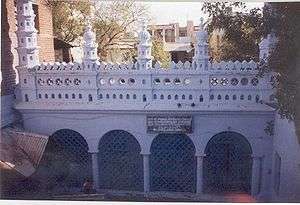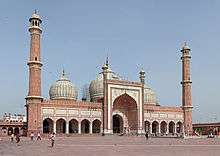Kazimar Big Mosque
| Kazimar Big Masjid | |
|---|---|
|
| |
| Basic information | |
| Location | Madurai, India |
| Geographic coordinates | 9°54′46″N 78°06′51″E / 9.91275°N 78.1142°ECoordinates: 9°54′46″N 78°06′51″E / 9.91275°N 78.1142°E |
| Affiliation | Sunni, Hanafi |
| Leadership |
Govt. Qazi of Madurai: Syed Khaja Mueenuddeen |
| Website | http://www.maqbara.com |
| Architectural description | |
| Architectural type | Mosque |
| Architectural style | Indo-Islamic, |
| Date established | 1284 |
| Specifications | |
| Capacity | 1200 |
| Length | 210 metres (690 ft) |
| Width | 32 metres (105 ft) |
| Dome(s) | 1 |
| Minaret(s) | 8 |
| Minaret height | 32 metres (105 ft) |
| Materials | Calcium sand stones |

Kazimar Periya Pallivasal or Kazimar Big Mosque is the oldest mosque in Madurai city, Tamil Nadu, India. The mosque was founded by Kazi Syed Tajuddin, a descendant of the Islamic prophet Muhammad, who came from Yemen during 13th century and received this land from the King Kulasekara Ku(n) Pandiyan.[1] The mosque which was the first Muslim place of worship in Madurai.[2][3]
The mosque, which can accommodate about 1,500 people, is within 500 metres of the Periyar (central) bus stand, within one kilometre southeast of Madurai Junction railway station[4] and 1.5 km southwest of the Meenakshi Temple.
Maqbara

Madurai Maqbara, the grave (dargah) of Madurai Hazrats (Sheikhuna Meer Ahamad Ibrahim Periya, Sheikhuna Meer Amjad Ibrahim Chinna and Sheikhuna Syed Abdus Salaam Ibrahim Saalim - descendants of Muhammad) is located inside the mosque.[5] Almost all of Kazi Syed Tajuddin's descendants (Huqdars of this mosque called as Syeds) have lived in the same locality (Kazimar street) for more than 700 years, and have managed the mosque since then.[6] Syed Tajuddin was appointed as Kazi of the sultans, and till today his descendants who live at Kazimar street, Madurai, are appointed as Kazis to the Government of Tamil Nadu. Sheikhuna Meer Ahmad Ibrahim well known as Periya was appointed as Chief Qazi (Qaziyul Quzzat) of Madurai by the government of Nawab of Arcot. All Syeds belong to the Sunni sect of Islam, its Hanafi school and most of the descendants of Kazi Syed Tajuddin are Shazulis who practice the sufi order (Tariqa) Fassiya ash Shadhiliya.[7]
Madrasasa
Kazi Syed Tajuddin arabi Madrasah is located inside the mosque campus in which around 120 students learn basic Arabic.This madrasa managed by kazimar big mosque is run by Moulavi Hafil Syed Alimullah Baqavi.
Kazis of Madurai
The huqdars of this mosque have been appointed as Kazis of Madurai to the government since the 13th century, from the period of Qazi Syed Tajuddin. The present government Qazis of Madurai, Moulana Moulavi A.Syed Khaja Mueenudeen[8] is huqdar of this mosque and a descendant of Qazi Syed Tajuddin.
Imams
The founder of this mosque Kazi Syed Tajuddin himself was Imam of this mosque during his life time. The service of presiding the daily prayers and Friday sermons (Imamat and Qitabat) are done by the descendants of the founder Qazi Syed Tajuddin, from his period until today. The present Imams Moulavi Hafil Syed Muhammad Mueenuddeen Ibrahim Faizi, Moulavi Hafil Syed Alimullah Baqavi have been in service since 1998.
Management
Kazimar Big mosque has been managed by the descendants of Kazi Syed Tajuddin without any break since the inception of the mosque.[9] The genealogical records of all the heirs of kazi Syed Tajuddin and the managers of this mosque are maintained in the mosque office. There are around 450 heirs of Kazi Syed Tajuddin (Syeds - Huqdars of this mosque) who constitute the general body from among whom the management committee is selected. Presently, the mosque is being managed by a board of four trustees selected from, among and by the Huqdars of this mosque who are the descendants of the founder of this mosque Kazi Syed Tajuddin. Their tenure is for three years. In January 2017 the General body of huqdars of the mosque resolved to increase the seats in the management committee from four to fourteen. The earlier committee of four would be trustees and the additional committee of ten would be executive members.
References
- ↑
- ↑ Shokoohy, Mehrdad (2003). Muslim Architecture of South India: The Sultanate of Ma'bar and the traditions of maritime settlers on the Malabar and Coramandel Coasts (Tamil Nadu, Kerala and Goa). Inter-India Publications. ISBN 0-415-30207-2.
- ↑
- ↑ "ஹாஜிமார் பெரிய பள்ளிவாசல் மதுரை".
- ↑ "Maqbara Hazrats accepting Fassiyatush Shadhiliyya". www.maqbara.com.
- ↑ "Clipping of Express Publications - The New Indian Express-Madurai".
- ↑ "About Us". Madurai-Tamil Nadu-India. Retrieved 10 May 2018.
- ↑ "Region's earliest interface with Islam was here - Times of India".
- ↑ "Express Publications The New Indian Express-Madurai epaper dated Fri, 2 Feb 18".

